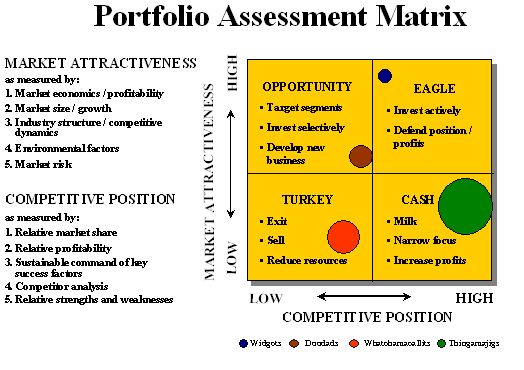 Feed the Eagles, Starve the Turkeys: Feed the Eagles, Starve the Turkeys:
Achieving Success Through Portfolio Segmentation
By Mark W. Sheffert
July 2002
When I was a kid, you could tell when somebody’s dad “made it,” because he would trade in the
Chevy for an Oldsmobile or a Buick.
In those days, General Motors was dominant, and there were probably fewer than 20 brands of cars
in the market. GM pioneered a process called portfolio segmentation by offering a stair-step selection
of cars - from Chevrolet to Oldsmobile to Buick to Cadillac - to take advantage of consumers’
changing pocketbooks and preferences as they moved up from segment to segment of the market.
Over the next 40 years or so, GM gradually segmented the market within each of its brands, so you
could buy a Buick that was less expensive than an Oldsmobile, and an Olds that was cheaper than
some Chevys. At the same time, imported cars flooded the American automobile market, offering even
more choices to consumers.
Eventually, there were more brands and models than there were market segments. Fierce competition
erupted. GM was no longer dominant, and the once clearly defined Oldsmobile market segment
became blurred and crowded with competitors. The Oldsmobile brand faded away and was recently
buried by GM.
This is a case of a company that created a brilliant strategy under one set of market conditions, but
was not able to effectively maintain that strategy when market conditions changed. GM didn’t
anticipate the intense competition from overseas or understand that market segments are fluid. What can be learned from the demise of GM’s Oldsmobile line? That the markets and segments you
compete in today will probably undergo major changes or disappear completely in a few years.
Re-thinking who and how you choose to serve in markets is especially significant during an economic
downturn. Recently, management and technology consulting firm Booz-Allen Hamilton surveyed
top executives at large companies to understand how they’re responding to the recession. About 90
percent were either experiencing a downturn in business or preparing for a possible downturn. Most
had implemented classic discretionary cost-cutting measures such as reducing headcount, cutting travel
budgets, decreasing bonus pay, trimming IT investments, and cutting training and development.
But how do they know where to cut or when a cut is good or bad? How do they know if a short-term
expense reduction today will compromise long-term competitiveness?
The solution is for business owners and managers to know which market and product segments are
value creators (we’ll call them eagles) and which are value destroyers (turkeys). Then they can
increase attention and resources to the eagles and decrease resources to turkeys, or exit those
segments entirely.
Especially in an economic downturn, companies find that value creators provide a greater share of
profits, while the value destroyers erode profits at an increasing pace. The strategic imperative is clear:
Feed the eagles and starve the turkeys!
To differentiate between turkeys and eagles, it’s necessary to objectively assess the attractiveness of
the markets in which you compete, your competitive position in those markets, and your company’s
relative strengths and weaknesses. In my experience, the best tool for conducting this analysis is a
formal portfolio assessment.
Market Attractiveness
By following a few simple rules and applying a few key measurements, you can quickly and accurately
determine the attractiveness of markets or segments. A key rule is to disaggregate revenue streams.
While it makes for easy accounting to track a single revenue stream, it is misleading. Any market or
product segment that produces more than 10 percent of revenue should be treated as a separate
business or strategic business unit (SBU) for assessment purposes.
After the revenue stream is segmented and SBUs are identified, you need to understand the
attractiveness of each market in which each SBU competes. For instance, if one of your SBUs
manufactures widgets, you need to know how widgets stack up against the following key
measurements:
- What are the market economics for widgets?
- How big are the widget market and industry? How fast are they growing each year?
- What is the widget industry structure and what are its competitive dynamics?
- How will environmental factors (i.e., demographics and economic, technological, and political
change, etc.) affect the widget market today and in the future?
- What risks lie in the widget market (i.e., obsolescence)?
Answers to these questions are what you need to determine the widget market’s attractiveness.
Do this for each SBU, then you’re ready for the second part of the portfolio assessment: determining
your competitive position and relative strengths and weaknesses.
Competitive Position - Strengths and Weaknesses
Again, answering a few key questions will help you understand your competitive position
within your market(s):
- What is your share of the available market for widgets?
- What is the profitability of your widget SBU relative to that of the market and competitors?
- Can you sustain command of the key success factors for the widget market?
- Who are your key competitors in the widget market, and what is their relative
competitive position?
- What strengths will allow you to capitalize on widget market opportunities and what
weaknesses make you vulnerable to widget market risks?
During this analysis, it is imperative that you not be like the golfer who shot a hole-in-one and wrote
down a zero on his scorecard. You’ll simply be fooling yourself, and that will take you down the
wrong path.
Portfolio Assessment Matrix
Armed with information about each SBU’s market attractiveness and your competitive position, you
are ready to document your findings on a portfolio assessment matrix. For many years, I’ve used the
matrix on page 20, because it clearly illuminates the options a company may want to pursue for its
positioning. Plot your SBUs in the appropriate spot on the matrix according to revenue. For example,
plot your widgets SBU, doodads SBU, whatchamacallits SBU, and thingamajigs SBU with circles whose
sizes represent the amount of revenue you enjoy from each one.

By plotting the SBUs on the matrix, it becomes clear what your strategy ought to be. The most
attractive quadrant is the eagle, where both the market attractiveness and your competitive position
are high. These are the SBUs to feed by actively investing in them. Conversely, those in the bottom left
quadrant are turkeys, to starve by reducing resources or exiting the segment. The upper left quadrant
represents opportunities in which to selectively invest, while the bottom right quadrant represents cash
cows to milk for profits.
Portfolio Segmentation in Action
Portfolio segmentation helps a company objectively choose strategic options and direction. My
firm recently worked with a local public company that had two business lines, both in very mature markets.
The markets were not growing and were unattractive, and the company had a very small share of them. By plotting the two revenue streams on the portfolio assessment matrix, it became obvious they had some
turkeys on their hands. They sold those businesses.
On the other hand, the company had a new product concept with high market attractiveness and a
good competitive position. This is where the company’s opportunity lies, and where it is now investing
its resources.
A well-known example of a company that practiced portfolio segmentation is Abbott Laboratories, which
understood that although 99 percent of its revenues came from pharmaceuticals at the time, it could not
become the best pharmaceutical company in the world. But it could become the best at creating a product
portfolio that would lower the cost of health care. Through portfolio segmentation and analysis, Abbott
Labs shifted its focus away from drugs to create a lower-cost product portfolio, principally hospital
nutritional products, diagnostics, and supplies. Abbott has been very successful since it made the change.
So don’t be a turkey and rely on the status quo for your future success. Do a formal portfolio
assessment, and then you may fly with the eagles.
Back to Top |



